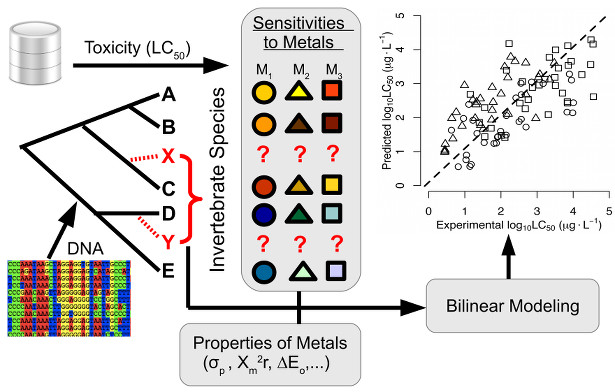In this post Egina Malaj talks about their recently published paper “Evolutionary patterns and physicochemical properties explain macroinvertebrate sensitivity to heavy metals”.

Illustration of the predictions of a bilinear model. The workflow starts with (i) DNA alignment and construction of the phylogenetic tree, (ii) collection of the toxicity data, and (iii) collection of properties of metals. From these three datasets, bilinear models are developed and validated enabling the prediction of untested toxicity of species x and y (see tree).
The toxicity of aquatic species is a crucial prerequisite for conducting ecological risk assessment. Given that laboratory toxicity tests for all species-chemical combinations cannot be conducted exhaustively due to practical, financial and ethical constrains, modeling of species toxicities represents an appealing alternative. In this study, a multivariate statistical approach was used that combined the genetic similarities of 31 invertebrate species and the chemical properties of six heavy metals.
The similarities of species are represented by the phylogenetic tree, the branches of which show the course of evolution from ancestors to descendants. The tree starts with the root which represents the common ancestors to all species in the tree. From the root emanate branches, which represent the course of evolution to descendants. The descendants reside at the nodes of the tree, and the branches emanate from these nodes, eventually reach the tips, where the species under investigation reside. Given the increased availability of genetic data, the phylogenetic tree in this study was constructed based upon DNA and RNA sequence comparison.

The complete phylogenetic tree as shown in the paper. The main divisions are: (1) phylum: AR=Arthropoda, NE=Nematoda, ANN=Annelida, ML=Mollusca; (2) class: BR=Branchiopoda, MA=Malacostraca, IN=Insecta, GA=Gastropoda; and (3) order; AM=Amphipoda, DE=Decapoda, AN=Anostraca, CL=Cladocera, DI=Diptera.
To account for variation in toxicity for multiple chemicals, their physicochemical characteristics are often related to the observed toxicity. The similarities of species represented by the phylogenetic trees and the physicochemical characteristics represented by chemical properties (e.g., the softness parameter) were combined in a multivariate statistic approach, also known as bilinear modeling. This modeling technique will enable the user to predict the toxicity of species with unknown toxicity (e.g., experimentally untested species) based on the toxicity of species with known toxicity (e.g., experimentally tested species).
Bilinear models explained 70-80% of the variability in toxicity to heavy metals, where the major part of the explained variance was attributed to phylogeny (>40%). Predicted values were in strong agreement with experimental values (>50%), therefore, this approach can be used to predict toxicity values for untested invertebrate species based on similar species for which toxicity has been tested. Despite their good performance, development of bilinear models would benefit from an improved phylogenetic and toxicological dataset. This analysis is one of the few examples linking evolutionary biology with applied ecotoxicology, and its potential applications can be expanded to other stress factors or trait properties influencing aquatic organisms.
The paper “Evolutionary patterns and physicochemical properties explain macroinvertebrate sensitivity to heavy metals” was authored by Egina Malaj, Guillaume Guénard, Ralf B. Schäfer, and Peter von der Ohe and published in Ecological Applications.
